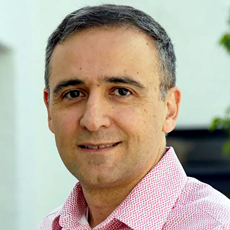Technical Lecture

from https://chic.caltech.edu/hajimiri/
Prof. Ali Hajimiri
Bio: Professor Hajimiri’s group does research on electronics and photonics integrated circuits and their applications in various disciplines, including high-frequency and high-speed communications, sensing, imaging, and bio-sensing. His research group engages in both the theoretical analysis of the problems in photonics and electronics integrated circuits and biomedical devices as well as practical implementations of new systems.
Prof. Ali Hajimiri received his B.S. degree in Electronics Engineering from the Sharif University of Technology, and M.S. and Ph.D. degrees in electrical engineering from the Stanford University. Before joining the Faculty of Caltech, he worked for Bell Laboratories, Sun Microsystems, and Signetics (Philips Semiconductor). In 1998, he joined the Faculty of the California Institute of Technology, Pasadena, where he is Bren Professor of Electrical Engineering and Medical Engineering, Director of Caltech Holistic Integrated Circuit Laboratory, and co-Director of the Space-based Solar Power Project. His research interests are high-speed and high-frequency electronics and photonics integrated circuits for applications in sensors, photonics, communication, wireless energy transfer, and biomedical devices.
Prof. Hajimiri is the author of “Analog: Inexact Science, Vibrant Art” (Early Draft pdf) a book on fundamental principles of analog circuit design and “The Design of Low Noise Oscillators” (Boston, MA: Springer). He has authored and coauthored more than 300 refereed journal and conference technical articles and has been granted more than 170 U.S. patents and has many more pending applications.
He is a Fellow of National Academy of Inventors (NAI). Prof. Hajimiri was selected to the TR35 top innovator’s list. He is also a Fellow of IEEE and has served as a Distinguished Lecturer of the IEEE Solid-State and Microwave Societies. He won the Feynman Prize for Excellence in Teaching, Caltech’s most prestigious teaching honor, as well as Caltech’s Graduate Students Council Teaching and Mentoring award. He is also three-times winner of the Associated Students of Caltech (ASCIT) Undergraduate Excellence in Teaching Award. He was the Gold medal winner of the National Physics Competition and the Bronze Medal winner of the 21st International Physics Olympiad, Groningen, Netherlands. He was a co-recipient of the IEEE Journal of Solid-State Circuits Best Paper Award, the International Solid-State Circuits Conference (ISSCC) Jack Kilby Outstanding Paper Award, a co-recipient of RFIC best paper award, a two-time co-recipient of CICC best paper award, and a three-time winner of the IBM faculty partnership award as well as National Science Foundation CAREER award and Okawa Foundation award. He co-founded Axiom Microdevices Inc., whose fully-integrated CMOS PA has shipped around 400,000,000 units, and was acquired by Skyworks Inc.
He serves on the Technical Program Committee of the International Solid-State Circuits Conference (ISSCC) as the chair of the technology directions sub-committee, and has served as an Associate Editor of the IEEE Journal of Solid-State Circuits (JSSC), as an Associate Editor of IEEE Transactions on Circuits and Systems (TCAS): Part-II, a member of the Technical Program Committees of the International Conference on Computer Aided Design (ICCAD), Guest Editor of the IEEE Transactions on Microwave Theory and Techniques, and Guest Editorial Board of Transactions of Institute of Electronics, Information and Communication Engineers of Japan (IEICE).
"Noise in Oscillators: from Understanding to Design"
RFIC 2024 Technical Lecture
Abstract: In this technical lecture, we will discuss the fundamentals of noise processes within an oscillator and the associated design insights. We will start with understanding evolution of noise from device and external noise sources to phase noise. We will develop the time-varying phase noise model, discuss some of the nuances involved in it, and how a deeper understanding of that process can help us identify additional intuition in design of voltage controlled oscillators (VCO). We will investigate specific applications of this model to various kinds of oscillators, such as LC ad ring VCOs and how it fits with the general picture of frequency generation.